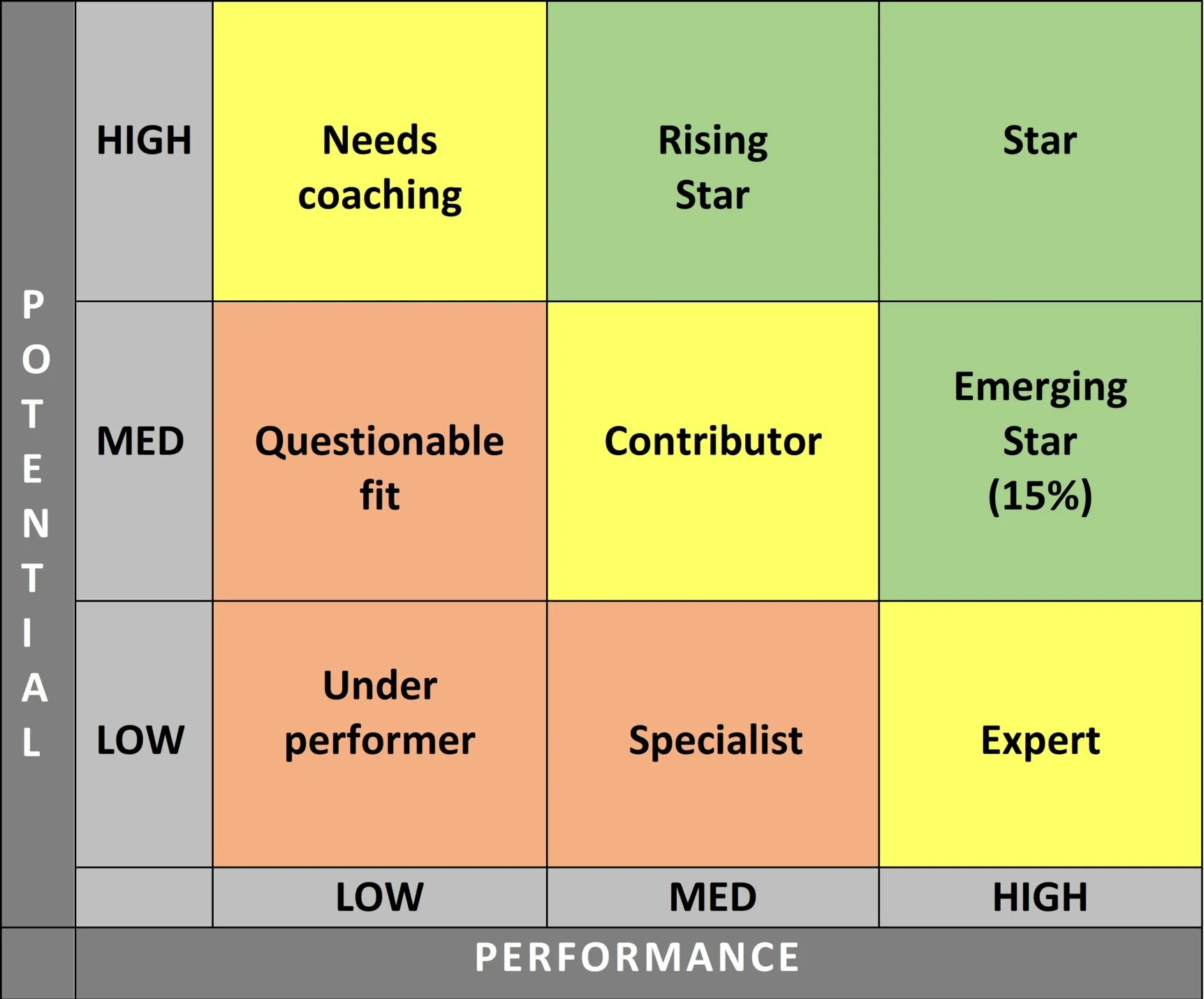Why You Should Be Using Career Vectors
Vector: a quantity having direction as well as magnitude
Vectors are a wonderful way of describing a career because they show a direction and intensity without specifying an end-point. Beyond retirement, there is no clear end to someone’s career, just pivots and shifts. Maybe there are big shifts based on the needs of a job, a business, an industry, or a personal motivation, but the original direction and force has a huge influence no matter the change. Career momentum is an asset.
And that’s why so many businesses get it wrong.
Oh Nine-Box, how I loathe thee.
The Traditional Career Path
Today, my readers, we are going through a typical career pathing conversation.
Are you an entry-level role, perhaps fresh out of college or starting in a new industry? Great, there are a number of vaguely communicated success criteria that rank you on a 1-5 scale and they probably have little relevance to the day to day work in your role. However, unless you really bungle something, you’re going to get a 2-4 based on how good your relationship with your manager is. Maybe you’ll get a five on something if it impressed someone. This middling scorecard and your manager are the only ways to demonstrate that you should advance your career at this organization. And don’t think of asking a colleague about career growth options: the disembodied level criteria (if they even exist) are haphazardly communicated or adhered to across the organization.
Oh, you’re midlevel? Super, the results and reviews from your team explain your performance (btw, there’s only a management track at this organization; no growth options for expert individual contributors). If you have a good mentor or manager, you’ll get some advice on how to wring more success out of the team. If you don’t...well, hopefully your team is good enough despite you being their manager. Even if you were the best sales rep or an innovative individual contributor, your success is gated by the impact and feedback surveys from your team. If you were promoted from within, odds are that your great individual contributor skills and knowledge make up less than 25% of your new responsibilities. The other 75%? Good luck, you’re on your own. Have fun!
And at the executive level, hopefully everyone under you gets results! Remember, since you’re at the top then there’s nothing to strive for besides better results. Or a tighter relationship with the board. Probably both if you want to last long-term. If you’ve never done the C-suite before, you have to pen your own user manual or hire an executive coach that someone on your board thinks is a waste of money. By the way, you don’t have time to develop a personal understanding of everyone you manage, so you have to depend on your direct reports to execute your strategy effectively.
What a conversation. Explaining to someone in an entry level role how to move up the chain is complicated. Since this is a traditional organization, there needs to be a business need, an open role, you have to be great at your current job (even though few of those skills will help you at the next level), and you have to be liked. Everything changes, more time is spent on recruitment than internal training, and career pathing tends to be a reactive process so it’s more likely to be last on the organization’s priority list. Whatever career momentum you’ve built has to fit into their plans on their schedule.
Midlevel to executive- neigh impossible. Might as well move to another organization that’s ready to hitch you to their drive train. Besides, that salary bump elsewhere makes it worth your while, rather than figure out how to climb where you are.
Does this sound like your organization?
When you let career pathing be organic
There’s a charm when you hear career stories where someone started at the front desk and survived through a chaotic time and ended up in a leadership role. It’s the American Dream: start somewhere and end up somewhere better through hard work and tenacity. Capitalize on opportunities! Go outside your comfort zone! Be lucky!
Being lucky is not a career best practice. An organic career path is by nature paved by the ambitious but rarely walked by others. An effective career path grows people and crushes business outcomes to then open up new channels for employee growth and development. An organization should sculpt channels that encourage people that are willing to work hard and be tenacious to grow themselves meaningfully and strategically.
How a Career Vector Works
Career vectors create a concise and specific direction that is the marriage of business goals and corporate values. A well-written vector can capture the essence of what it means to work on this team in this organization layered on top of the most defining business feature of that team/department. Good vectors are deeply contextual, which is why it’s a little hard to define them in a vacuum.
Let’s dive into one example to see the career vector in action: Risk-Adjusted Decision-Making
The Context
A team does stock trading for customers as an added service in a larger organization. The rest of the organization produces a product or delivers a service, but the trading team provides customers with expert advice to get the most value out of stock trades.
Business outcome
The trading team provides a value to customers based on how good their trading outcomes turn out. If the team provides bad advice that results in bad trades, customers lose money. The team’s impact on the business is judged by how consistently they generate the best returns to customers. Managing and mitigating risk is a core skill for this team, no matter how junior or senior the employee is.
Corporate Values
The business, broadly, wants to be seen as a trusted advisor. It’s important that these transactional stock trades build long-term value for customers, so it behooves the trading team to make long-term smart decisions. The business value of being a trusted advisor means the trading team needs to demonstrate reliability and foster trust that the customer will benefit at the end of the day. A short term loss that generates a lot of long-term value trumps quick wins that are high-risk.
Vectors in Action
With a career vector like “risk-adjusted decision making”, conversations about career growth start in the same place but can end up in a lot of destinations based on the context of the person and their unique blend of skills, knowledge, and experience:
An entry level role is given a small scope to demonstrate risk-adjusted decision making.
A mid-level role has a larger scope, advise on deals that have higher risk, or manage a team that collectively manages medium risk.
A senior role manages diversified risk, high value risk, or previously unexplored risk, either individually or managing a team.
For someone to move forward in their career on the trading team, they need to develop the skills, knowledge, and experience to manage risk well. If they want to be a senior individual contributor, great: enjoy high-risk high-value global trading as the team expert. If an employee wants to move into a management track, great: enable your team to make fantastic risk-adjusted decisions. As a manager, you can provide them information to make better decisions, or train them to understand different kinds of risk, or hire people who bring in strong decision making skills. No matter the starting point or the destination, the vector for growth should align to their ability to make smart decisions based on risk.
If your team needs a more granular breakdown of the skills, knowledge, and experience to move forward, having the risk-adjusted decision making vector makes it easy to flesh out the particulars. Alternatively, someone can be motivated and ambitious to improve their ability to execute risk-adjusted decisions and carve a new path for the business...and the business is totally cool with that because it’s in line with business outcomes.
The Pros and Cons of Career Vectors
Pros:
Vectors allow teams to be super specific about their career levels/roles or be very broad and flexible
There is a clear understanding of what matters in a team with a single career vector
Allows creative expression in reaching excellence and rewards the motivated high potentials
Rewards skill building, knowledge gaining, and historical experience rather than politics and likeability
Vectors can be refined, adjusted, nudged, or adapted to a variety of contexts as the business evolves.
Cons:
Requires up-front work to effectively marry values and business outcomes. Not only that, but through the design process it showcases misaligned values and business outcomes
Diminishes the personality value that employees bring to work. Someone who is a team player, works well with others, but doesn’t deliver on a specific vector is OUT
It’s really hard to effectively capture the expert individual contributor and manager track with a single vector. It’s elegant when you do it right or Frankenstein when it’s done wrong.
If business outcomes or corporate values shift, vectors need to be rethought. Then again, this should be happening for career pathing regardless.
How do you start figuring out Career Vectors?
It really starts with a conversation. At a strategic planning session or over a few beers, the question, “What’s the most important factor for success on this team” is a solid starting point. Bring in the full team and ask them what they think is the most important factor for success on the team. It might be enlightening to hear what the most junior employee thinks is needed to move forward on the team.
Once the skunkwork is done, layer in a vision.
What business outcomes does/should my team own?
Based on our corporate values, how should we achieve those business outcomes?
Developing consistent answers to these two questions and then aligning it with what the team sees as “success” is where the magic starts to happen. If you’re doing this well, people start to say, “Well of course that vector makes sense!”
Like any good strategic initiative, execution is 50% of the work. A career trajectory should be felt at performance reviews, 1-1s, quarterly check-ins, corporate surveys, recognition events, promotion process, hiring interviews...the list goes on. A well thought out vector but weak execution is doomed to fail.
For organizations looking to step their toe into the framework, start with a small team. Go in deep and make it part of their everything, even for three people. Give them six months and keep a finger on the pulse of their output and satisfaction metrics. Set up 360s after the pilot to see how performance and engagement changed. If they like it...well, there’s your data that it works. If they don’t, figure out why and use it to inform your next performance management strategy.
If you want help thinking through career vectors- even for a smaller organization- Learn to Scale can be a great facilitator for navigating a career pathing exercise. It helps having fresh eyes curate the process to ask questions that insiders might take for granted. Most smaller organizations don’t have the time or people on staff to facilitate a career pathing conversation, but a few hours on an afternoon might generate a huge value for your people.
Where might your career lead? Where might theirs?





